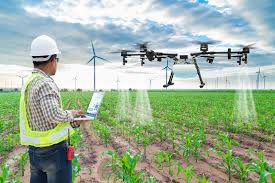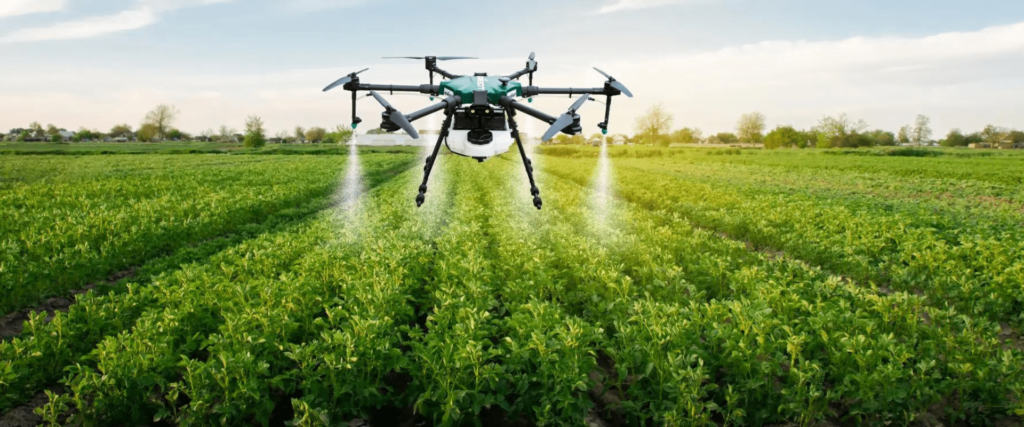In recent years, the American agricultural industry has seen a silent but powerful revolution. From the cornfields of Iowa to the vineyards of California, more and more farmers are turning to drone technology to monitor crops, boost production, and cut costs. With climate change, labor shortages, and rising expenses pressing hard on the industry, drones are offering a high-tech lifeline.
This shift is no longer limited to large commercial farms. Small and mid-sized farmers are also adopting drones to increase their yields and compete in an ever-demanding market.
A New Era of Smart Farming

Farming in the United States has always evolved with technology. Tractors replaced horse-drawn plows. GPS transformed field mapping. Now, drones—also known as unmanned aerial vehicles (UAVs)—are taking agriculture to new heights, quite literally.
These flying machines are equipped with advanced sensors, high-resolution cameras, thermal imaging, and GPS navigation. They can scan entire fields in minutes, providing real-time data that would take humans days to gather.
According to a 2024 report by the American Farm Bureau Federation, over 35% of large-scale farms in the US now use drones as part of their daily operations. This number is expected to rise to 60% by 2028.
How Drones Help Boost Farm Yields
Farmers are using drones in various ways to improve productivity:
- Crop Monitoring and Health Analysis:
Drones can detect signs of plant disease, nutrient deficiencies, and pest infestations early, allowing farmers to act quickly before the problem spreads. - Precision Agriculture:
By collecting data on soil condition, plant health, and moisture levels, drones help farmers apply fertilizers and water more efficiently. This targeted approach reduces waste and increases crop output. - Planting and Spraying:
Some advanced drone models can plant seeds or spray pesticides and fertilizers. These drones work faster than traditional methods and can access difficult terrain without damaging crops. - Field Mapping and Planning:
With high-definition aerial images, farmers can create detailed maps of their fields to monitor changes over time, plan harvests, and make informed decisions.
Real-Life Success Stories

For farmers like John Miller in Nebraska, drones have made a significant impact. “I started using drones in 2022 for crop monitoring,” he says. “Now, I can check 300 acres in an hour without leaving my truck. I spotted a fungus early in one section and saved thousands of dollars in lost yield.”
Similarly, Emily Reyes, who manages a fruit farm in Oregon, uses drones to monitor water usage. “It’s been a game-changer. We reduced water waste by 40% and improved the health of our trees.”
These examples highlight how drone technology is not just about convenience—it directly affects the bottom line.
Challenges Farmers Still Face
Despite the benefits, drone adoption is not without hurdles:
- High Initial Costs:
Advanced agricultural drones can cost anywhere from $2,000 to over $25,000. While prices are dropping, many small farmers still find the investment steep. - Technical Training:
Using drones effectively requires some technical skills. Farmers need to learn how to operate drones, interpret data, and maintain equipment. - Regulations and Privacy Laws:
The Federal Aviation Administration (FAA) regulates drone use, and farmers must follow rules related to airspace, flight height, and licensing. Navigating these regulations can be confusing, especially for new users.
To support adoption, many states and agricultural universities now offer drone training programs and workshops for farmers.
Government and Industry Support

Recognizing the role of drones in improving food security, the US government and private tech companies are increasing support for precision farming initiatives.
The USDA has expanded funding for tech upgrades on farms, while companies like John Deere, DJI, and AgEagle are working on user-friendly drone models specifically designed for farmers.
In some cases, cooperatives are pooling resources to buy drones collectively, sharing costs and benefits among local farmers.
The Future of Drone Farming in America
Experts agree that drones are here to stay in American agriculture. As the technology becomes more affordable and accessible, even more farmers are expected to adopt drones in the coming years.
New innovations like AI-powered drones and fully automated spraying systems are already being tested. These advancements could make drone use even more efficient and valuable in the face of unpredictable weather, labor shortages, and rising demand for food.
“Drones won’t replace farmers,” says Dr. Lisa Grant, an agricultural technology researcher. “But they will give farmers better tools to do their job smarter, faster, and more sustainably.”
Conclusion
As American farmers look for ways to maximize productivity and deal with modern challenges, drone technology is proving to be a powerful ally. From monitoring crops to optimizing water and fertilizer use, drones are helping boost yields and reduce costs. And as adoption spreads, this quiet revolution could reshape the face of American farming for generations to come.
Read more :- Top 10 Best American Superfoods That Boost Immunity Naturally





